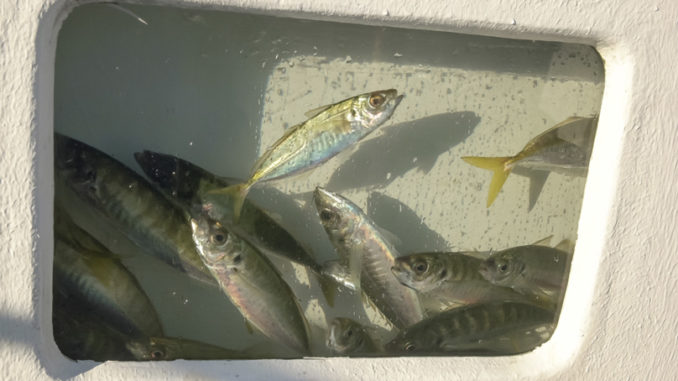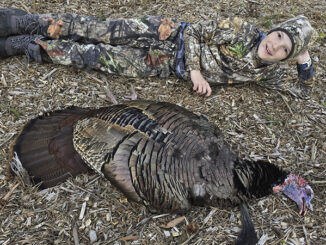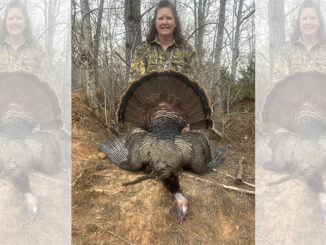
Baitwell maintenance is critical to keeping baitfish alive
If anglers want to use live bait, they have to be able to keep the little fish alive. That sounds pretty basic. But as I examine more baitwells, I’m continually bombarded by the fact that not all manufacturers devote much time or effort to getting this crucial component correct.
No doubt that opening paragraph will have some folks believing I’m off my rocker. But if the shoe fits, no amount of spin doctoring will solve the problem. It’s probably caused because many baitwells are a last thought. They often become merely a place to hold water in a boat and are shaped or plumbed in a way that doesn’t function well.
Recently I overheard a salesman at a boat dealership telling a potential customer the baitwell in his boat held hardtails (blue-runners) well. I waited until they’d moved away and stepped into the boat to look at the baitwell.
It might, and the key word is might, keep hardtails alive. But in North Carolina, we fish with menhaden. And pogies wouldn’t have lasted more than a few hours in that baitwell.
Many baitwells are lacking in design and function
Many boat manufacturers retool existing boats, introduce new models, and do all sort of things to attract customers. But rarely do they install a well-designed baitwell.
It can’t be prohibitively expensive. Many anglers buy boats, then replace or re-work the baitwells before using them. So customers obviously will spend money to have a good bait-carrying system.
Anglers almost always make necessary changes to get the results they want. We don’t want any compromises, just a baitwell that addresses all of our concerns and is capable of keeping bait fresh and lively all day.
Doesn’t anyone remember “If you build it, they will come”?
There are two basic types of baitwells — one recirculates the same water while the other provides a constant exchange of fresh water (a few are rigged to operate both ways).
What shape is your livewell?
With my background as a live-bait king mackerel fisherman, let’s first discuss baitwells with a constant exchange of water.
Baitwell definitions begin with shapes. Sometimes shrimp and a few species of minnows will survive for a while in a square or rectangular baitwell. But round is the preferred shape. Oval is a reasonable second shape, but the corners must be well radiused and not short angles.
Flowing water doesn’t turn corners well. And, in short corners, the water flow misses some water deep in the corners and doesn’t get exchanged and re-oxygenated. Any bait that stays in this water will suffer a loss of oxygen, weaken and eventually die.
Unfortunately, moreso than any other baitfish, menhaden have an amazing tendency to find their way into a corner and not be able to find their way out. In a baitwell with short corners, they “cornify” themselves until they weaken and eventually expire.
Proper baitwells do more than move water and oxygen
For best results, water should enter a constant-exchange baitwell at or very near the bottom, so it’s angled to flow around the baitwell, circulate several times and exit at the top.
I’m not an engineer, but even I understand this routing procedure introduces cooler, better oxygenated water at the bottom of the baitwell, allows it to circulate several times as it warms and releases oxygen before being removed at the top.
The rising and warming water in a baitwell also picks up some of the bodily excretions of the bait and removes them from the water. Ammonia and urine are a pair of the more common bait wastes the water can carry and remove.
Another problematic waste is feces. Unfortunately, water that’s flowing fast enough to pick up and carry feces is often detrimental to the bait, so it must be removed otherwise.
Baitwell pump ratings are often incorrect
To remove feces and any other solid or heavier-than-water waste, a small drain in the center of the bottom of the baitwell works well. Many baitwells have a large drain in or near their center. And using it for removing the solid waste can be as simple as making a reducing bushing or including a valve to slow the flow. This drain must have enough suction (flow) to help pull the waste out, but not be large enough to seriously interfere with filling the baitwell and disturb the circulation of the water while it’s full. Usually 3/8 to 1/2 inch is about right.
The water in a constant-exchange baitwell should be completely exchanged numerous times every hour. Baitwell pumps are rated at zero head pressure and at open flow, which means their ratings are optimistic and rarely correct.
Usually there are constrictions (hard bends, casting blocks, etc.) in the hose and/or fittings. So the water has to be raised, which creates flow restrictions and head pressure.
In a transom or leaning-post baitwell, most 800 GPH pumps work well enough to average 500 to 600 GPH. Add some water loss through the drain removing the solid waste and an 800 GPH pump may only turn over the water in a 50-gallon baitwell about eight times an hour. This is sufficient as long as the water is well oxygenated.
Check your baitwell’s turnover rate
Turnover rate can be checked by timing how many minutes it takes a baitwell to fill from empty to full overflow. (The actual rate of turnover will be slightly longer than the fill time because the pump won’t operate as efficiently with the pressure of a tank full of water holding it back as it does nearly empty. But this is a reasonably close measure). Simply divide the number of minutes to fill a baitwell into 60. That determines the number of times the water turns over in an hour.
Water flow and pressure are somewhat related, but flow is good while pressure isn’t. Extra flow brings more fresh water and oxygen to the bait. But extra pressure can harm the bait by beating it up.
An example: water flowing out of an open garden hose rarely has enough pressure to clean or hurt. But adding a nozzle to the hose increases the pressure to the point it’ll scour light residue and can hurt when pointed at bare skin from short distances. The same is true with the scales and flesh of baitfish and the shells of shrimp.
One easy solution to keep good flow in a baitwell while reducing pressure is to increase the hose size between the pump and baitwell.
You want the water to flow, but with reduced pressure
I often use baitwell pumps with a 3/4-inch exhaust and increase this to 1 1/4- or 1 1/2-inch hose and fittings for the last few inches before the hose enters the baitwell. The amount of water flowing into the tank remains the same, but the pressure will be reduced by more than 50 percent.
The amount of oxygen in the water is important. As we see when comparing the ability to hold bait during the heat of the summer with holding bait during the cooler spring and fall, warm water doesn’t hold oxygen as well as cooler water. Unfortunately, this isn’t a matter of cooling off the water after it is introduced into the baitwell. The water absorbs its oxygen well before then. Also, don’t be misled to believe any constant-exchange baitwell will bring enough oxygen to the bait simply because of constant flow. Many work well. But most can be improved.
I’ve experimented with adding pure oxygen and air. This hasn’t been extensive testing, but I prefer air. Even better, I believe baits respond better to air in most cases.
These adjustments will help
Rarely are less-expensive solutions superior, but this is one of those times. The savings are significant.
A good backyard handyman can make these changes in a few hours.
KeepAlive, Inc., of Tarpon Springs, Fla., makes several versions of oxygen and air infusors, with appropriate fittings. KeepAlive also makes some step-up, through-the-hull fittings that simplify reducing pressure while maintaining flow. These are special parts and not carried in every store. But your favorite tackle shop should be able to order one for you. Or visit the KeepAlive web site at www.keepalive.net.
Water temperature is also important. As noted earlier, warm water doesn’t hold oxygen as well as cooler water. At first look, it appears cooling baitwell water will help as much as oxygenation. Unfortunately, putting bait caught in warm water into cool water often shocks them beyond recovery.
Most anglers agree a difference of a couple of degrees can help hold bait, but at about 4 to 5 degrees the difference becomes a liability, not a plus. Besides, adding ice or a frozen water bottle to a complete exchange baitwell barely cools a little of the upper-level water before it’s drained by the overflow.
Shrimp have different needs than small fish
Flow and pressure were mentioned earlier, but only in reference to baitfish. Shrimp are lighter than minnows, and they don’t swim particularly well. And they are far more likely to be banged into something and injured in a baitwell with a highly pressurized flow.
My recommendation for holding shrimp is to put something in the bottom of the baitwell for the shrimp to hold to and not get swept about by current. This isn’t as important in a baitwell that’s merely oxygenated and has no real water flow. But it can be crucial in a baitwell operating with complete exchanges multiple times each hour.
Several anglers have said they drop their bait net into the baitwell and let the shrimp cling to it. This may work, but it seems strange to introduce a vertical obstruction to water circulation.
It’s not difficult, but it is important, to have an excellent baitwell
I use several layers of plastic hardware cloth that are zip-tied together and held on the bottom by fishing weights. Mine is a non-corrosive solution and doesn’t stain the baitwell and contaminate it between uses. Some metals will do both if forgotten and left in the baitwell when not in use. Plastic hardware cloth quickly can be inserted to hold shrimp or removed to hold fish, and it stores easily.
Having an excellent baitwell isn’t difficult. If anglers are having problems keeping bait alive and healthy, these recommendations should help resolve those issues.
Each tip will help to a limited degree and, when used in conjunction, they should combine to give anglers the healthiest and most-active baits.
That often makes the difference between catching or merely going fishing.





Be the first to comment